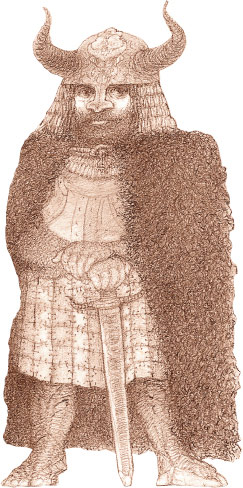
After the migration of the Oldbucks east of the Brandywine River, and the founding of Buckland, a forceful new leader appeared among the Hobbits of the Shire. His name was Isumbras Took. Appropriately, Isumbras is an Old English name meaning Iron Arm (isen~iron, bras~arm). He was soon acclaimed Isumbras I, the Thirteenth Thain of the Shire, and the First Thain of the Took line. With the transfer of the Thainship to the Took family, the Fallohidish Tooks became the most important family in the Shire. For centuries thereafter, the Thainship became synonymous with the head of the Took clan. Hobbits used the terms Thain and Old Took interchangeably.

Great Smials  Tuckborough
Tuckborough  Tookland
Tookland  Took
Took  Tuk
Tuk  Tuck TUCCA
Tuck TUCCA
BUCCA
 Buck
Buck  Oldbuck
Oldbuck  Brandybuck
Brandybuck
 Buckland
Buckland  Bucklebury
Bucklebury  Brandy Hall
Brandy Hall

ORIGIN OF THE TOOKS
Tolkien does not give us the name of the founder of Tookland and the progenitor of the Took family. However, if one looks at the genealogy of Bucca as the progenitor of the Oldbucks and Brandybucks, we can do a little linguistic detective work and soon discover the answer.
Tolkien gives us clues. We are told that the Great Smials of Tuckborough in Tookland were the seat of the Took family and that an earlier version was Tûk. If we compare this to Brandy Hall of Bucklebury in Buckland as the seat of the Brandybuck family, and the earlier name Oldbuck, we can see that there is a parallel development. Just as the founder of the Brandybuck/ Oldbuck family was Buck or Bucca, so the founder of the Took/Tûk family must be Tuck or Tucca.
Indeed, it seems quite logical that the eponymous progenitors of these dynasties were originally brothers: Bucca and Tucca of the Marish, after whom Buckland and Tookland were named.
FAMILY OF TOOKS
The Hobbit name of Tucca/Tûk/ Tuck/Took itself has contributed much to the characteristics of a family notable for its bold Fallohidish nature and larger-than-life personalities. If we look at the descendants of Old Tucca it becomes clear that the characteristics came with the Took name.
As English surname, Took and Tuck stem from Old Norse names suggestive of Thunder. They are both diminutive forms of the rather ferocious Old Norse Thorkil or Thurkettle. The English word took, as the past tense of take, is also suitably bold and direct. It, too, comes from an Old Norse source: taka meaning to seize, but came to modern English through the Old English tucian, meaning to disturb, afflict.
TOOK AND TUCK:
English surnames of Old Norse origin
~Diminutive of THORKIL~
THOR’S HILL or THUNDER HILL,
that is, the thunder god’s hill
~Diminutive of Thurkettle~
THOR’S KETTLE or THUNDER CAULDRON
that is, the thunder god’s sacrificial cauldron
However, Tucca/Tûk/Tuck/Took also has its softer side. The names Took and Tuck have a more homely, Hobbitish nature built into them as well. Just as we discovered that Baggins meant “substantial snack, afternoon tea,” we find a similar meaning for the Took/Tuck family. (They were, after all, related; and the Tooks and Bagginses would often “tuck into a tea” together.) Tuck is defined as “food, eatables; especially cakes and sweets.” Thus we have tucker, which is Australian slang for food in general; and tuck shop, meaning a sweet or cake shop on school premises.
This meaning of the name Tuck is the probable reasoning behind the name of that famous fat character, known as Friar Tuck, in the legend of Robin Hood. Indeed, with his cheerful manner, rotund shape, and large appetite, Friar Tuck would have made an admirable Tookish Hobbit had he been about half his actual height. Added to every-thing else, both the Friar and the Took Hobbits were noted as crack shots with a bow and arrow.
GREAT SMIALS OF TUCKBOROUGH
At the end of the first millennium, after the Shire’s founding, Isengrim II, the Twenty-second Thain, and the Tenth Thain of the Took line, began the Took clan’s excavations beneath the Green Hills of Tookland.
These excavations, known as the Great Smials, were dug deep into the high and undulating escarpment of the Green Hills. Below the Smials, along the base of the massive tunnel-riddled rampart, is the rest of Tuckborough, the largest settlement in the Shire.
Isengrim, meaning Fierce Iron (isen~iron, plus grim~fierce) was an appropriate name for the chief architect of the Great Smials of Tuckborough. It is possible that Isengrim II spent too much time hobnobbing with Dwarves, for his imagination appears to have been inflamed by ambitions that were far beyond what was right and proper for a sensible Hobbit.
Perhaps it was the Took name itself that inspired Isengrim. These Great Smials of Tuckborough might well be described as a Tookish “thunder god’s cauldron” built into the cliff face of a Tookish “thunder god’s hill.”
The Great Smials are certainly the closest that Hobbits ever came to monumental architecture. They constitute the primary home of the Took clan, and the Tooks are certainly the largest, wealthiest, and most ostentatious Hobbit family in the Shire.

Great Smials of Tuckborough